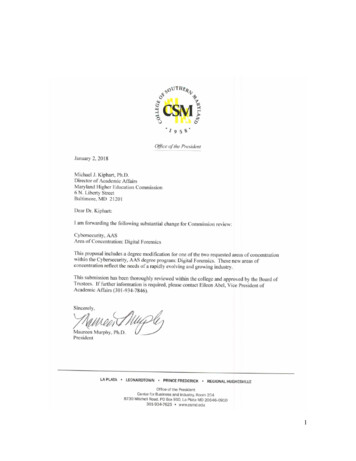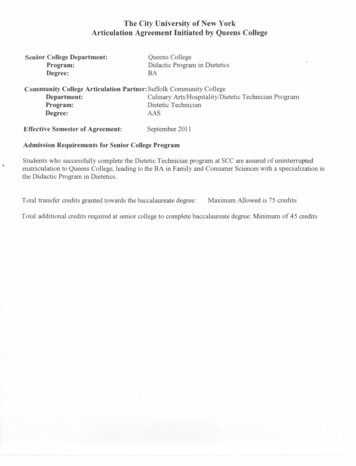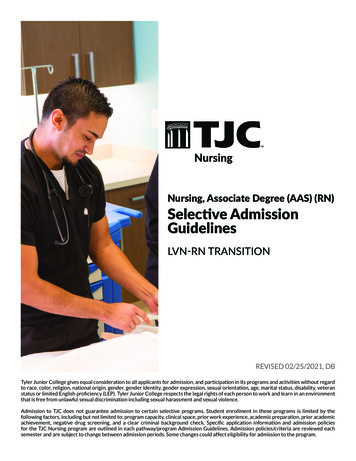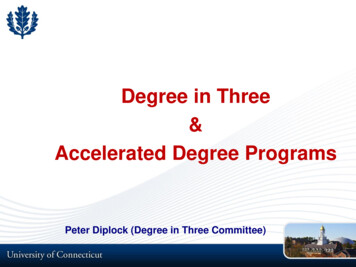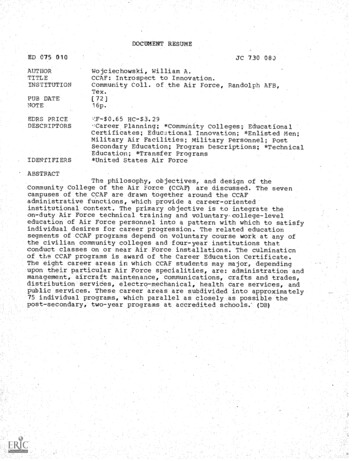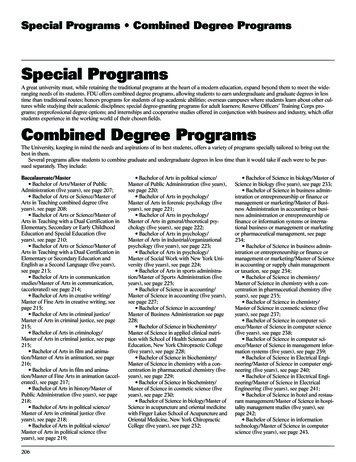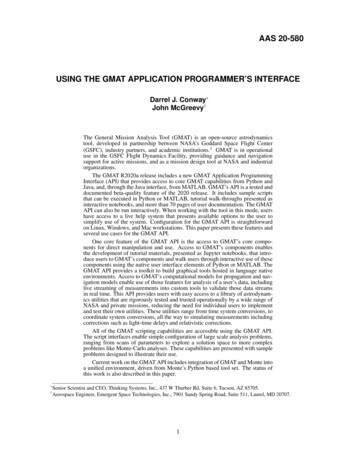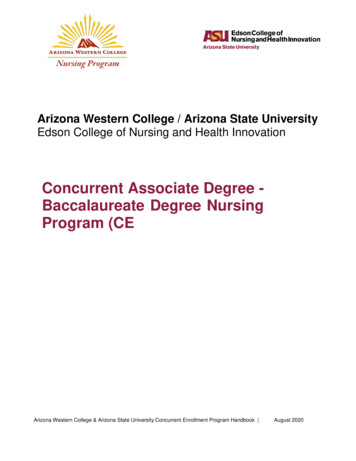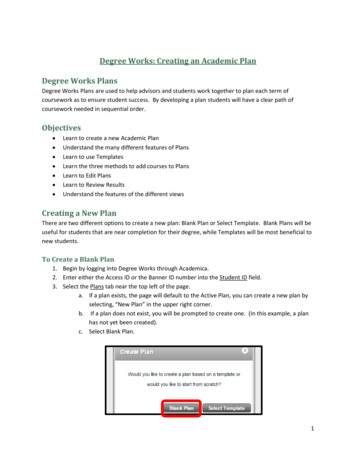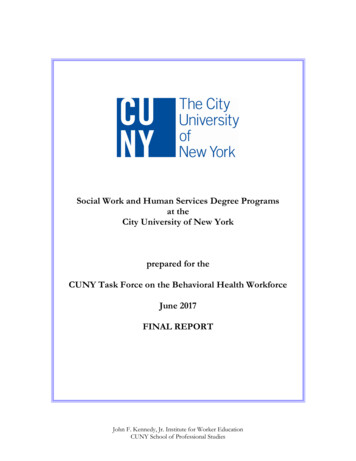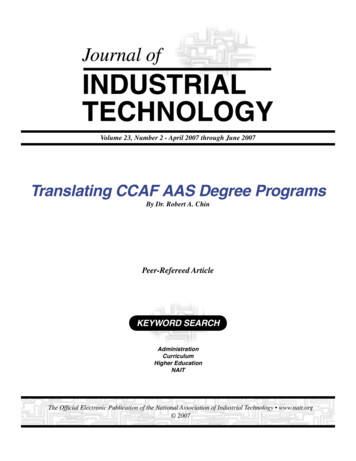
Transcription
Volume 23, Number 2 - April 2007 through June 2007Translating CCAF AAS Degree ProgramsBy Dr. Robert A. ChinPeer-Refereed ArticleKEYWORD SEARCHAdministrationCurriculumHigher EducationNAITThe Official Electronic Publication of the National Association of Industrial Technology www.nait.org 2007
Journal of Industrial Technology Volume 23, Number 2 April 2007 through June 2007 www.nait.orgTranslating CCAF AASDegree ProgramsBy Dr. Robert A. ChinAbstractDr. Robert A. Chin is Professor and BS in Design program coordinator, Department of Technology Systems,College of Technology and Computer Science, EastCarolina University, where he has taught since 1986. Inaddition, he is a member of the East Carolina Universityand Indiana State University graduate faculties. Chinreceived his Ph.D. from the University of Maryland, College Park; M.A.E. from Ball State University; B.A. fromthe University of Northern Colorado, and A.A.S. from theCommunity College of the Air Force. Before joining theE.C.U. faculty, he was on the College of Education facultyat the University of Maryland, College Park. Chin is aJIT reviewer; the recipient of the 1995 NAIT President'sAward, University Division; the recipient of the 1997 NAITOutstanding Regional Director Award, University Division; and a Laureate member of Epsilon Pi Tau.A relation of equivalence for Community College of the Air Force Associatein Applied Science degree programsand industrial technology-orientedcivilian Associate in Applied Sciencedegree programs was investigated. Thepurpose was to facilitate acceptance ofCommunity College of the Air ForceAssociate in Applied Science degreeprograms for transfer to baccalaureatedegree-granting institutions that prepare industrial technologists. Relationof equivalence was pursued throughthe use of specialized computer filesmaintained by the National CrosswalkService Center that articulate the relationship between Air Force Specialtycodes developed by the U. S. Air Force,occupational codes developed by theBureau of Labor Statistics, and codesdeveloped by the National Center forEducation Statistics that represent postsecondary instructional programs. Thefindings indicate a relation of equivalence exists between selected Community College of the Air Force Associatein Applied Science degree programsand selected civilian industrial technology-oriented Associate in AppliedScience degree programs. Specialized computer files maintained by theNational Crosswalk Service Centercan be used to facilitate acceptance ofCommunity College of the Air ForceAssociate in Applied Science degreeprograms for transfer to baccalaureatedegree-granting institutions that prepareindustrial technologists.IntroductionThe traditional role of the Associatein Applied Science (AAS) degree hasbeen to improve the employment opportunities of degree holders for entryinto specific careers or occupations.This is in contrast to the traditional roleof the Associate in Arts (AA) degree,whose primarily purpose is to preparegraduates for the rigors of upper divi-2sion baccalaureate work. Although theAAS’s objective is to facilitate directemployment, numerous baccalaureatedegree-granting institutions, includingmany that administer industrial technology programs, offer upper divisionprograms that accept AAS degrees inpartial fulfillment of the baccalaureatedegree (e.g., East Carolina University,2006; Kent State University, 2006;Morehead State University, 2006;Northern Illinois University, 2006;Southeast Missouri State University,2006).Community College of the Air Force(CCAF) graduates are a viable sourcefor 2 2 industrial technology programsor industrial technology degree completion programs that lead to a bachelor’sdegree. They not only possess theacademic preparation in their specialty,but they will have fulfilled humanities,social and behavioral sciences, writtenand oral communication, and mathematics requirements, all of which are animportant part of the academic preparation of industrial technologist (NAIT,2006a). More importantly, becauseof graduation requirements, all CCAFgraduates will possess several years ofwork experience. CCAF graduates canbe a viable asset to industrial technology student bodies, classes, and labsbecause of what they possess.While NAIT defines industrial technology (NAIT, 2006a) and it operationallydefines industrial technology by theprograms it accredits (NAIT, 2006b),CCAF degree program titles still useAir Force terminology and reflectAir Force occupations, which maybe difficult for college and universityadmissions personnel and the civiliancommunity in general to translate. Theproblem of this study was to identifyindustrial technology-oriented Community College of the Air Force Associate in Applied Science (CCAF AAS)
Journal of Industrial Technologydegree programs. The purpose was tofacilitate acceptance of CCAF AASdegree programs for transfer to fouryear industrial technology programs,whether they are 2 2 industrial technology programs or industrial technologydegree completion programs that leadto a bachelor’s degree.The Community College of the AirForceThe Community College of the AirForce (CCAF), located at MaxwellAFB, Alabama, is the largest community college in the world. Nearly 7,500instructors in 100 schools affiliatedwith the college teach degree-applicable courses. Its affiliated schoolsare located in 36 states, the District ofColumbia, six foreign locations, andone territory, and are accredited by theSouthern Association of Colleges andSchools (SACS) through January 1,2009.The programs administered by theCCAF are designed to help enlistedAirmen meet future technological andleadership challenges of the UnitedStates Air Force by combining AirForce technical training with generaleducation course work from accredited civilian colleges. Each year about1.6 million semester hours are earnedin CCAF classrooms. Since issuingits first degree in 1977, the collegehas awarded more than 258,000 AASdegrees. More than 380,000 enlistedpersonnel including regular Air Forcemembers, Air National Guard personnel, and Air Force Reservists areregistered with almost 113,000 Airmenactively pursuing a CCAF degree.The College offers 67 degree programsthat encompass 129 Air Force SpecialtyCodes (AFSC) or what the NationalAssociation of Industrial Technology(NAIT) refers to as programs options(National Association of IndustrialTechnology [NAIT], 2006a). All CCAFdegree programs require a minimum of64 semester hours (SH) from the following areas: Physical Education, 4 SH;Technical Education, 24 SH; GeneralEducation, 15 SH; Leadership, Management, and Military Studies, 6 SH; andProgram Elective, 15 SH. Volume 23, Number 2 April 2007 through June 2007AFSCs are alphanumeric identifiersof occupational specialties and skilllevels and are used by the Air Force toidentify Air Force Specialties (AFS).Enlisted member AFSCs consist of fivecharacters. The first (number) denotesthe career group (1, Operations; 2,Maintenance/Logistics; 3, Support; 4,Medical/Dental; 5, Legal/Chaplain;6, Acquisition or Finance; 7, SpecialInvestigations; 8, Special Duty Assignments; 9, Special Reporting Identifiers).The second character (letter) denotesthe career field. The third character(number) denotes the career field subdivision. The fourth character (number)specifies the skill level (1, 3, 5, 7, and9), and the fifth character (number)denotes further job division within thesame career field subdivision.Career Progression of CCAF Students/Enlisted AirmenEnlisted members of the Air Forcebegin their career with Basic Military Training (BMT) with the rank ofAirman Basic. Following BMT, theybegin AFS training at one of five AirForce installations.Airmen are awarded a "1" (helper) levelwhen they enter technical school fortheir AFSC. Upon graduation fromtechnical school, they are awarded a "3"(apprentice) level. Depending on thelength of the technical school, Airmencan be promoted to the rank of Airmanand later Airman First Class upon meeting time-in-grade requirements. Withthe 3 level and once time-in-service andtime-in-grade requirements are met,Airmen can be promoted to the rank ofSenior Airman.Airmen are normally awarded a "5"(journeyman) level after a period of onthe-job training (OJT) and completionof correspondence courses, called Career Development Courses (CDC). Depending on the job, this process can lastup to 18 months. With the 5 level andonce time-in-service and time-in-graderequirements are met, Airmen can bepromoted to the rank of Staff Sergeant.To fulfill the requirements for a CCAFAAS degree, Airmen are required tohave earned their 5 (journeyman) level3 www.nait.orgin the appropriate AFSC.Upon promotion to Staff Sergeant,Airmen enter training for their "7"(craftsman) level. Seven level trainingconsists of CDCs, OJT, and for someAFSCs, a 7-level technical school.Possession of the 7 level and fulfillmentof time-in-service and time-in-graderequirements are mandatory for promotion to the rank of Technical Sergeantand later, Master Sergeant and SeniorMaster Sergeant.Upon promotion to Senior Master Sergeant and following completion of alltraining requirements, Airmen receivea "9" (superintendent) level. With a 9level, completion of all training requirements, and fulfillment of time-in-service and time-in-grade requirements,Airmen can be promoted to the rankof Chief Master Sergeant (Air ForceDepartmental Publishing Office, 2006;Air Force Departmental Publishing Office, 2005).Description of the StudyKey to the pursuit of this study’s problem is the means for translating CCAFAAS degree programs to a form usefulby civilian communities. That is, howcan the somewhat vaguely familiarlanguage used to describe CCAF AASdegree programs be made more familiarto the civilian community, in as objective a manner as possible, to facilitateacceptance of CCAF AAS degreeprograms for transfer to baccalaureate degree-granting institutions? Onemeans lies in the resources availablethrough the National Crosswalk ServiceCenter (NCSC)—their Crosswalks inparticular.The NCSC manages technical resourcethat deal with occupational and trainingprogram classification systems (National Crosswalk Service Center [NCSC],2006c). Its mission is to maximize theeffective and efficient use of occupational information by providing specialized occupational tools (files, reports,and software) and technical assistanceto users and producers of occupationalinformation.
Journal of Industrial TechnologyTo make their point, they encouragereaders to remember what mothersuse to say: "Always use a crosswalkwhen crossing the street." Moreover,the Center illustrates their point bynoting that as those crosswalks helpedusers get from one side of the streetto the other, the crosswalks and othertools available from NCSC help usersget from one place to another (NCSC,2006c).Among the crosswalks maintained byNCSC, are the Military OccupationCode (MOC)-to-Standard OccupationalClassification (SOC) and the SOC-toClassification of Instructional Programs(CIP) Crosswalks. The result of ajoint effort between the Departmentof Education and the Department ofLabor, the purpose of the SOC-to-CIPCrosswalk is to show the relationshipsbetween program content and occupations, based on the descriptions of each(NCSC, 2006b).The SOC system is used by federal statistical agencies to classify workers intooccupational categories for the purposeof collecting, calculating, or disseminating data. All workers are classifiedinto one of over 820 occupations according to their occupational definition.To facilitate classification, occupationsare combined to form 23 major groups,96 minor groups, and 449 broad occupations. Each broad occupation includes detailed occupation(s) requiringsimilar job duties, skills, education, orexperience (Bureau of Labor Statistics,2000).CIP is a taxonomic coding schemethat contains titles and descriptions ofprimarily postsecondary instructionalprograms. It was developed to facilitateNational Center for Education Statistics (NCES) collection and reportingof postsecondary degree completionsby major field of study using standardclassifications that capture the majorityof reportable program activity. CIP isthe accepted federal government statistical standard on instructional programclassifications (National Center forEducation Statistics, 2002). Volume 23, Number 2 April 2007 through June 2007The MOC-to-SOC Crosswalk crossreferences military occupational codesof the Air Force, Army, Coast Guard,Marine Corps, and Navy with equivalent Federal Standard OccupationalClassification codes. The Crosswalkdata are intended to support both military and civilian research and analyticalfunctions that require military to civilian occupational conversion information. The content of the MOC-to-SOCCrosswalk file were developed by andcan also be accessed through the Defense Manpower Data Center (DMDC)at https://www.dmdc.osd.mil/owa/odb(NCSC, 2004). AFSCs are used by theDMDC to cross-reference AFS with theequivalent Federal Standard Occupational Classification codes.MethodologyCode CollectionCodes, including AFSCs and programtitles, for each CCAF degree programwere downloaded from the 2005-2007CCAF catalogue (Community Collegeof the Air Force, 2005). The MOC-toSOC and the SOC-to-CIP Crosswalkswere downloaded from NCSC (NCSC,2006a). Finally, and for the purpose ofthis study, the listing of all programsadministered by the North CarolinaCommunity College System (NCCCS)was downloaded (North CarolinaCommunity College System [NCCCS],2006). NCCCS administers associatedegree, certificate, and diploma programs organized around ten nologies, Arts and Sciences,Biological and Chemical Technologies,Business Technologies, Commercialand Artistic Production Technologies,Construction Technologies, Engineering Technologies, Health Sciences,Industrial Technologies, Public ServiceTechnologies, and Transport SystemsTechnologies.Figure 1 illustrates the procedure usedto translate CCAF degree programs. Itshows how tools available from NCSCand the 2005-2007 CCAF cataloguewere used to derive the relationshipbetween CCAF AAS degree programsand comparable civilian AAS industrialtechnology-oriented degree programs.4 www.nait.orgProcedureAll NCCCS Industrial TechnologiesAAS degree program titles and CIPcodes were identified and the corresponding SOCs were identified usingthe SOC-to-CIP Crosswalk. The SOCswere then used to identify corresponding AFSCs using the MOC-to-SOCCrosswalk. Finally, with the aid ofthe 2005-2007 CCAF catalogue, therespective AFSCs were used to identifycorresponding CCAF programs.In addition, the CIP codes for allNCCCS AAS degree programs fromthe Construction Technologies, Engineering Technologies, and TransportSystems Technologies program groupswere used to identify respective AFSCsand CCAF programs. The base for thisstudy was broadened to include programs from these three program groupsbecause across the nation programssimilar to these AAS degree programs are accredited by NAIT (NAIT,2006b). Furthermore, many becomepart of NAIT-accredited 2 2 industrial technology program or industrialtechnology degree completion programgraduation requirements that lead to abachelor’s degree (e.g., East CarolinaUniversity, 2006; Kent State University,2006; Morehead State University, 2006;Northern Illinois University, 2006;Southeast Missouri State University,2006). That is, in order for students topursue a NAIT-accredited 2 2 industrial technology program or industrialtechnology degree completion program,they must possess a qualifying technical AAS degree.FindingsNCCCS administers ten ConstructionTechnologies AAS degree programs,seventeen Engineering TechnologiesAAS degree programs, twenty-sevenIndustrial Technologies AAS degree programs, and eleven TransportSystems Technologies AAS degreeprograms. Of the 67 AAS degreeprograms/129 program options administered by CCAF, 22 AAS degreeprograms/42 program options alignthemselves with one or more of the 65
Journal of Industrial Technologyindustrial technology-oriented AASdegree programs administered by theNCCCS based on the CIP-to-SOC-toMOC comparison. The 22 AAS degreeprograms/42 program options that alignthemselves with one or more of theindustrial technology-oriented AASdegree programs administered by theNCCCS appear in Table 1 along withthe corresponding NCCCS programgroup(s) with which they are aligned.The seven different CCAF degreeprograms and their respective programoptions that align themselves with theConstruction Technologies programgroup appear in Table 2 aligned withtheir respective NCCCS programs. Theten different CCAF degree programsand their respective program optionsthat align themselves with the Engineering Technologies program groupappear in Table 3 aligned with theirrespective NCCCS programs. Thethirty-two CCAF degree programs andtheir respective program options thatalign themselves with the IndustrialTechnologies program group appear inTable 4 aligned with their respectiveNCCCS programs. The seventeen different CCAF degree programs and theirrespective program options that alignthemselves with the Transport SystemsTechnologies program group appear inTable 5 aligned with their respectiveNCCCS programs.DiscussionThe problem of this study was toidentify industrial technology-orientedCCAF AAS degree programs. Thepurpose was to facilitate acceptanceof CCAF AAS degree programs fortransfer to four-year industrial technology programs, whether they are 2 2industrial technology programs orindustrial technology degree completion programs that lead to a bachelor’sdegree.Virtually all industrial technologyprofessionals can probably, basedon CCAF AAS degree program title,program content, AFSC/program option, and the like, determine whethera CCAF AAS degree program is asuitable fit for transfer to a 2 2 indus- Volume 23, Number 2 April 2007 through June 2007 www.nait.orgTable 1. CCAF AAS Degree Program Titles and AFSCs that Correspond to One orMore NCCCS AAS Degree Program GroupsCCAF AAS Degree Program TitleAerospace Ground Equipment TechnologyAerospace HistorianAircraft Armament Systems TechnologyAviation Maintenance TechnologyAviation Maintenance TechnologyAviation Maintenance TechnologyAviation Maintenance TechnologyAviation Maintenance TechnologyAviation Maintenance TechnologyAviation Maintenance TechnologyAviation Maintenance TechnologyAviation Maintenance TechnologyAvionic Systems TechnologyAvionic Systems TechnologyAvionic Systems TechnologyAvionic Systems TechnologyBioenvironmental Engineering TechnologyBiomedical Equipment TechnologyComputer Science TechnologyConstruction TechnologyConstruction TechnologyConstruction TechnologyElectronic Systems TechnologyElectronic Systems TechnologyElectronic Systems TechnologyEmergency ManagementInformation ManagementInformation Systems TechnologyInformation Systems TechnologyLogisticsMaintenance Production ManagementMechanical & Electrical TechnologyMechanical & Electrical TechnologyMechanical & Electrical TechnologyMetals TechnologyMissile & Space Systems MaintenanceMunitions Systems TechnologyNondestructive Testing TechnologyPublic Health TechnologySafetyVehicle MaintenanceVehicle 12A7X24E0X11S0X12T3X12T3X2NCCCS Program Group(s)1ICII, TI, TI, TI, TI, TI, TI, TI, TI, TI, TI, TI, TI, TIIEC, IC, IEC, I, EC, I, EC, I, EC,IEEEIIC,ICII,TE,TIIIITTKey: C, Construction Technologies; E, Engineering Technologies; I, IndustrialTechnologies; T, Transportation Systems Technologies5
Journal of Industrial Technologytrial technology program or industrialtechnology degree completion programthat leads to a bachelor’s degree. Whenthere is doubt however, the Crosswalksprovided by the NCSC can provide anobjective “deciding vote” on whether aselected CCAF AAS degree program issuitable for acceptance.This study w
CCAF are designed to help enlisted Airmen meet future technological and leadership challenges of the United States Air Force by combining Air Force technical training with general education course work from accred-ited civilian colleges. Each year about 1.6 million semester hours are earned in CCAF classrooms. Since issuingFile Size: 377KB
